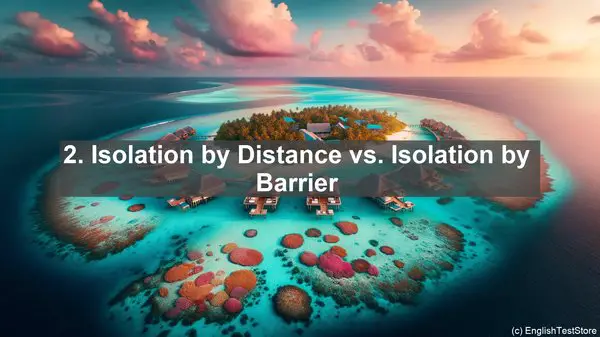Introduction: The Language of Landscape Genetics
Welcome to today’s lesson on the top 10 commonly confused words in landscape genetics. As with any scientific discipline, landscape genetics has its own unique terminology. However, some words often cause confusion due to their similar spellings or overlapping meanings. Today, we’ll demystify these terms, ensuring you have a solid foundation in this field.
1. Gene Flow vs. Genetic Drift
Gene flow and genetic drift are two fundamental processes shaping the genetic structure of populations. While both involve changes in gene frequencies, they differ in their mechanisms. Gene flow occurs when individuals migrate between populations, introducing new genetic material. On the other hand, genetic drift refers to random fluctuations in gene frequencies, often due to chance events. Understanding these processes is crucial for studying population dynamics and evolutionary patterns.
2. Isolation by Distance vs. Isolation by Barrier
In landscape genetics, understanding how populations become isolated is essential. Isolation by distance occurs when the genetic similarity between populations decreases with increasing geographic distance. This can be due to limited dispersal capabilities. On the other hand, isolation by barrier refers to the genetic differentiation caused by physical barriers, such as mountains or rivers. Both types of isolation play a significant role in shaping genetic patterns across landscapes.
3. Habitat Fragmentation vs. Habitat Loss
Habitat fragmentation and habitat loss are two processes that pose significant threats to biodiversity. While habitat loss refers to the complete disappearance of a habitat, fragmentation occurs when a habitat is divided into smaller, isolated patches. Both processes can have detrimental effects on species’ genetic diversity, as they limit gene flow and increase the risk of inbreeding. Conservation efforts often focus on mitigating these impacts.

4. Landscape Genetics vs. Spatial Genetics
Landscape genetics and spatial genetics are two terms often used interchangeably. While they share similarities, they have distinct focuses. Landscape genetics emphasizes the role of landscape features, such as topography or land use, in shaping genetic patterns. Spatial genetics, on the other hand, encompasses a broader range of spatial analyses, including the study of genetic clusters or spatial autocorrelation. Both approaches are valuable for understanding the spatial distribution of genetic variation.
5. Microsatellites vs. SNPs
When it comes to analyzing genetic data, researchers often use microsatellites and SNPs. Microsatellites are short, repetitive DNA sequences that can vary in length, making them useful for studying population structure. SNPs, or single nucleotide polymorphisms, are single base pair variations in the DNA sequence. They are more abundant in the genome and can provide higher resolution in some analyses. Choosing the appropriate marker is essential for addressing specific research questions.
6. FST vs. DAPC
FST and DAPC are two statistical methods commonly used in landscape genetics. FST measures the genetic differentiation between populations, with higher values indicating greater divergence. DAPC, or discriminant analysis of principal components, is a multivariate method that can identify genetic clusters without prior population assignment. Both approaches have their advantages and are often used in combination to gain a comprehensive understanding of population structure.
7. Resistance Surface vs. Conductance
In landscape genetics, resistance surfaces and conductance are terms associated with landscape connectivity. A resistance surface assigns different resistance values to different landscape features, reflecting their permeability to gene flow. Conductance, on the other hand, represents the ease with which individuals can move through the landscape. Both concepts are crucial for modeling gene flow and identifying potential barriers to dispersal.
8. Inbreeding vs. Outbreeding Depression
Inbreeding and outbreeding depression are two phenomena related to mating patterns. Inbreeding occurs when individuals with close genetic relatedness mate, leading to a higher frequency of homozygous individuals. This can increase the risk of deleterious recessive traits. Outbreeding depression, on the other hand, refers to reduced fitness in offspring resulting from mating between individuals from genetically distinct populations. Both processes have implications for conservation and population management.
9. Landscape Resistance vs. Permeability
Landscape resistance and permeability are terms often used in the context of gene flow. Landscape resistance refers to the degree to which a landscape hinders or facilitates movement. It can be influenced by various factors, such as habitat quality or the presence of barriers. Permeability, on the other hand, represents the ease with which individuals can move through the landscape. Understanding these concepts is crucial for predicting gene flow patterns and designing effective conservation strategies.

10. Population Structure vs. Population Differentiation
Population structure and population differentiation are terms used to describe the genetic composition of populations. Population structure refers to the presence of distinct genetic clusters within a species, often associated with limited gene flow. Population differentiation, on the other hand, quantifies the genetic divergence between populations. Both concepts provide insights into the evolutionary processes shaping genetic variation and are essential for conservation planning.
